The Jamestown Settlement & Yorktown Victory Center have a Annual Pass available to Virginia State employees for $20.50. I figured I could at least go twice this year before the OVPR events, plus a few weekends as motorcycle trips. So on Wednesday morning very very early I headed out for Jamestown.
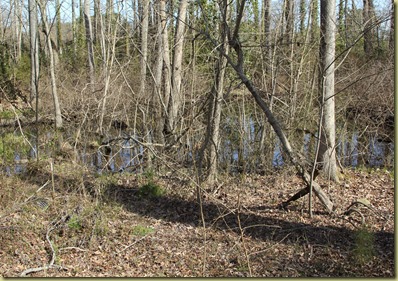
I got there just as they were opening. The Settlement is screened from the surrounding area by scrub growth, which had numerous boggy area partially due to the recent heavy rains.
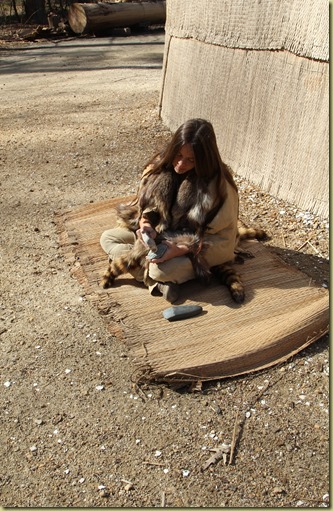
It was warm enough to be comfortable outside. This interpreter is making a stone ax, actually more of a splitting maul than a cutting ax. She said it takes about 30 hours to make but your grandchildren will still be using it long after you’re gone. There’s another ax on the mat in front of her, one with a shape copied from the Europeans.
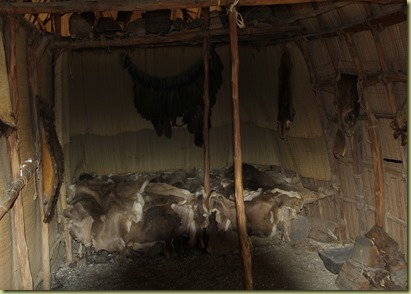
The Jamestown Settlement has a Powhatan village, the Jamestown village and 4 reproduction English ships. This is the interior of one of the Powhatan reed houses. It doesn’t have any post European contact things inside.
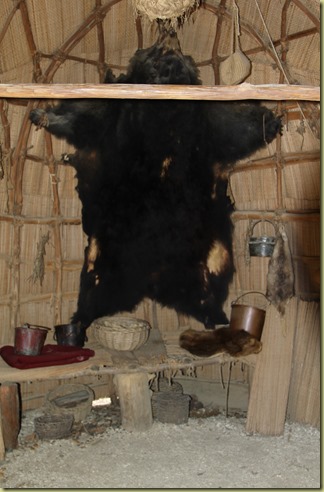
This Powhatan reed house is post contact and has European cookware and tools in it. The school groups were beginning to arrive about now and I wandered off towards the ships.
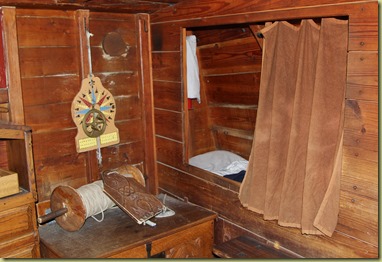
The 3 ships that brought the first Jamestown settlers here were built to be cargo ships. They had bed areas for the crew wedged in all sorts of places alongside the hull below decks.
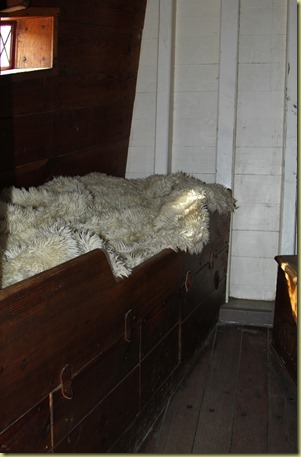
Of course the captain, 1st mate etc. had more open bed areas that were also longer than those of the common seamen.
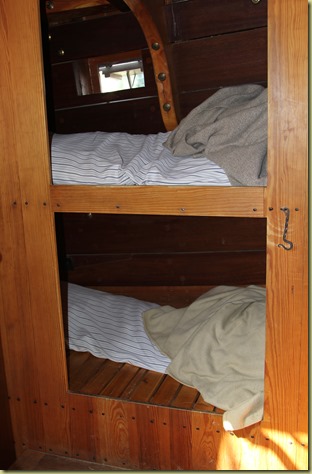
These sleeping cubicles are about 5’6” long and were quite narrow with limited head room. Do NOT sit up in bed, roll out of bed.
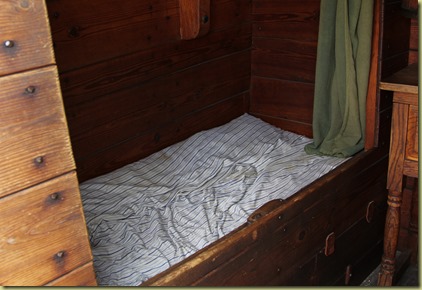
Another officer’s bed. The area below decks was tight enough that I had trouble getting far enough away from things for pictures.
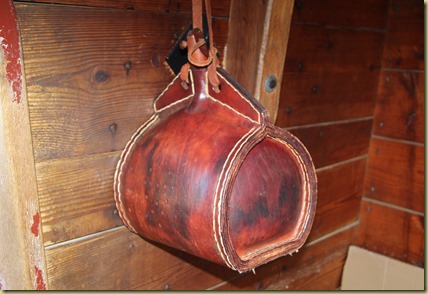
Of course the crew needs food as well as sleep. This leather canteen was for medicinal rum. Water was carried in barrels.
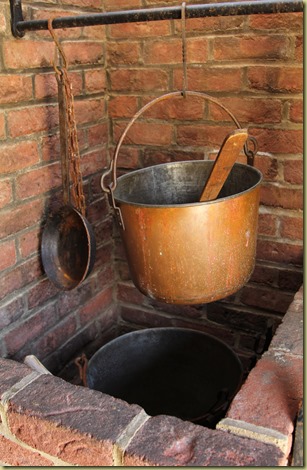
This is the “stove” for one of the ships. Yes its made of fire brick, after all a burning ship is not a grand after dinner show. On a cargo ship most meals were some version of stew, so 2 or 3 kettles and a few tools were all that was needed. Bon appetite.
![IMG_0134[4] IMG_0134[4]](http://lh4.ggpht.com/-cQy0ntozSF4/UVXUbM8W6jI/AAAAAAAADHo/UDEntzhpyH4/IMG_0134%25255B4%25255D_thumb%25255B2%25255D.jpg?imgmax=800)
Of course the captain would need a desk for the log book and the manifests along with some wine glasses. One on the rise in society must keep up appearances.
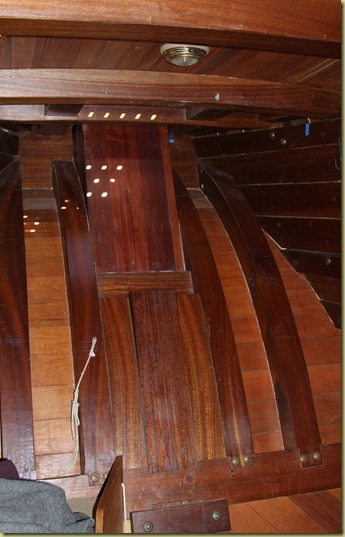
The quality of woodwork in a wooden ship had to be outstanding. The hull and its oakum had to swell to keep the ocean on the outside, but inside the wood needed to be highly varnished to prevent the wood from swelling and cracking from the damp atmosphere.
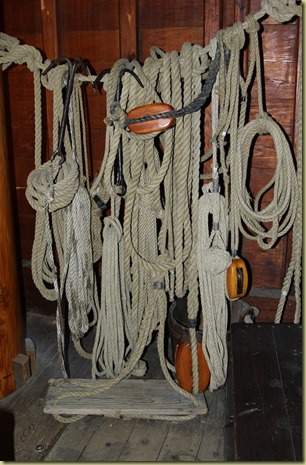
Of course ships also take constant maintenance. This is a storage area for both grappling lines and spare running rigging lines.
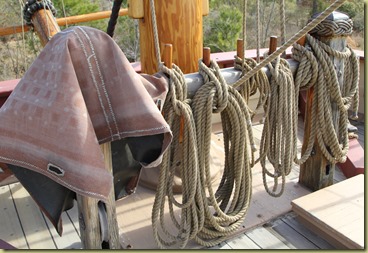
Ships rigging is more than a bit complicated. This is running rigging, the rigging used to control the sails, raise & lower the spars, etc.

This block has both running and standing rigging. The tarred lines hold things like masts in place. The tar free lines control things that are supposed to move but only when you want them to move.
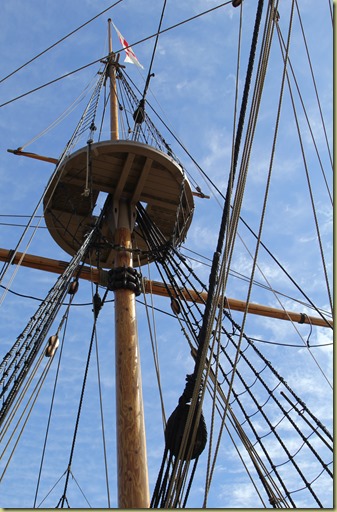
This here Hobbit does not want to climb up there, not on this ship, not on any ship.
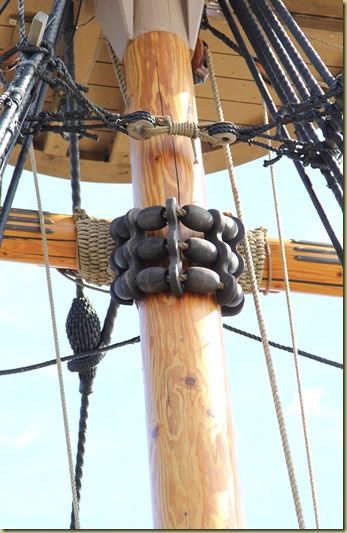
I was puzzled by the black wood things around the masts. They allow the spar to be rotated around the mast. The rope tied around the spar prevents the spar from getting all banged up while sailing. It needs frequent maintenance.
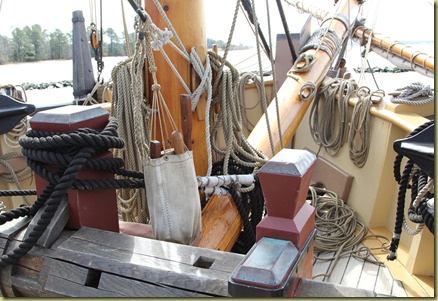
Normally you can walk into this area but they were doing standing rigging maintenance so the area was closed off. These ships are kept in ready to sail condition and are in fact periodically sailed.
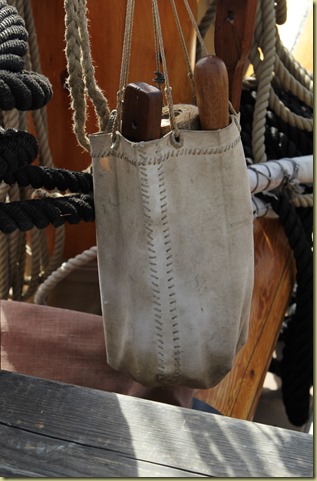
This is a Seaman’s Ditty bag, the bag of sail maintenance gear every able seaman was expected to have. A seaman wasn’t expected to be able to design a sail, just repair or make a sail as directed by an officer. The bag itself has all the stitch types needed for sail making and was a business card of sorts for the seaman. I have got to make me one of these.
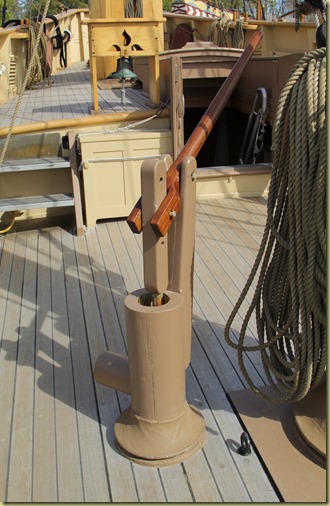
Of course, water is supposed to stay on the outside of a ship, but since it doesn’t always do that every ship has its hand pump to keep the area below deck from becoming a swimming pool.
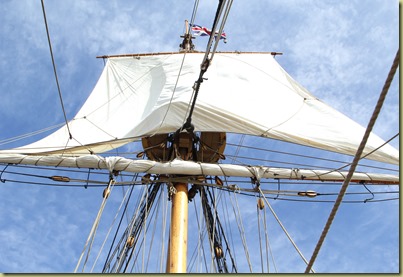
On days with little wind they lower a sail or two so they can explain how it all works. I still don’t want to climb up there.
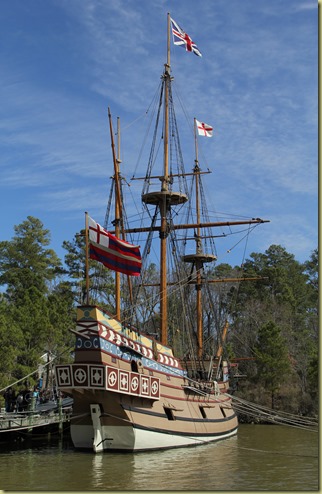
She’s lovely, she’s handsome, she’s well designed, and I don’t want to cross the Atlantic Ocean in anything this small. And this is the biggest of the 3 ships. Jamestown Settlement actually has 4 ships, one is no longer open for boarding. It is actually 1/3 smaller than it should have been and has been replaced by a better reproduction.
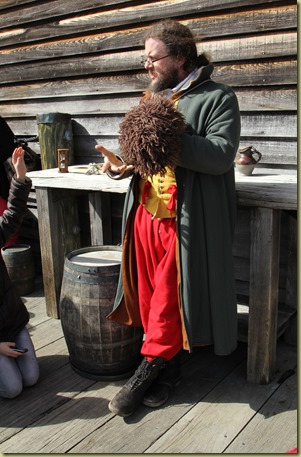
Here’s my friend Jay in his seaman’s attire giving a presentation to a school group. I wasn’t able to photograph most of the interpreters because they were surrounded by hordes of school kids.
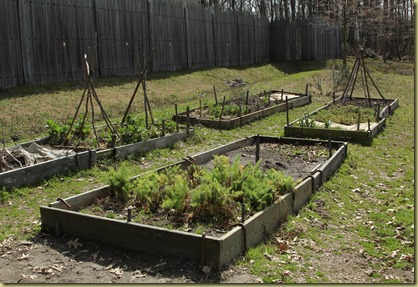
Outside the Jamestown stockade there are a whole bunch of raised bed garden areas. Now I doubt the lads who built Jamestown would have used raised bed gardens, Capt. Smith had a hard enough time getting them to work at all. But the raised beds make walking around the gardens easier, the better to show folks what they’re all about. Later in the year these gardens are full of vegetables.
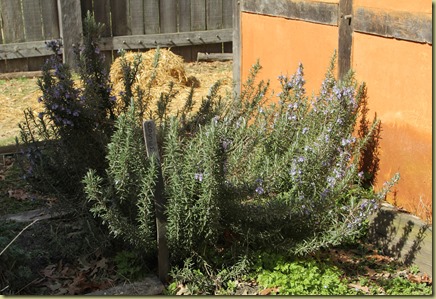
Inside the stockade there were little garden plots between the buildings. These seemed to be where herbs for cooking & medicinal use were grown. There were also small enclosures for various fowl.
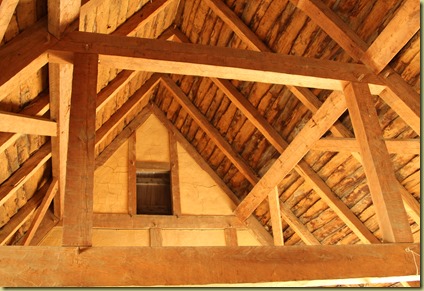
This is the post & beam framing that supports the roof of the shipping warehouse. Note the wooden slat roofing. Thatch roofing require a thatcher and that’s a skilled trade. Splitting roof slats with a froe & mallet, then pegging or nailing them to the roof joists requires can be managed with just a bit of practice.
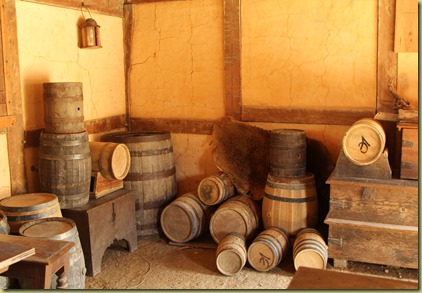
The warehouse itself was also post & beam construction with daub & wattle walls. This is the import & export building, although the colony had little to export for quite some time.
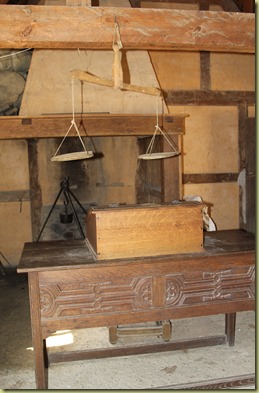
Here’s the counting table in the warehouse. In the summer you could work with the fire in front of you, in the winter with the fire warming your backside. The bills of lading were kept in the slant top desk, which could be removed to the clerk’s home for safe keeping.
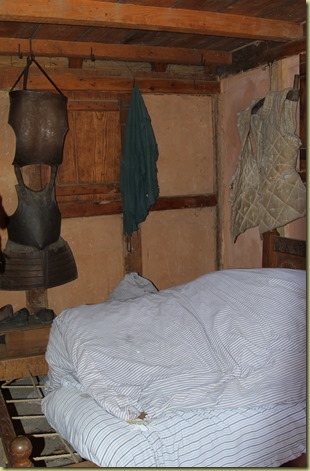
Common housing was very utilitarian but then so was common housing back in England. Personal items were hung on the wall, kept in chests or put in open cupboards.
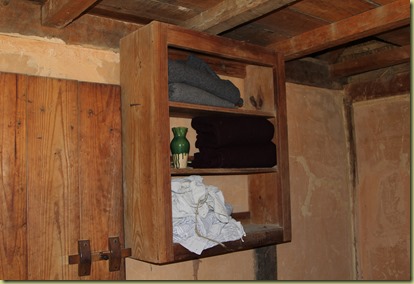
Most folks didn’t own all that much anyway. Here folks had even less since it all had to be made locally or shipped over.
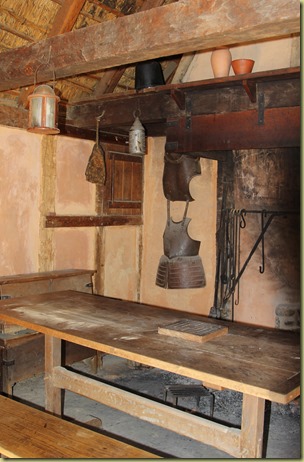
Jamestown was initially settled by men and boys only, so family housing wasn’t needed. It was more like a military outpost than a village. The building where most everyone slept wasn’t open, it was getting re-thatched. This was were everyone ate and where the cooking was done. The board on the table is a game board.

This is the warehouse for products produced by the colony. Its also got the equipment needed to hang hams etc from the rafters and all. The roof is thatch.
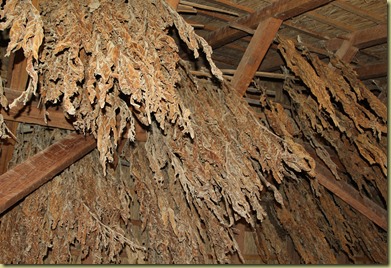
This is tobacco open air curing. Other curing methods will be used by the 1700’s.

Of course shipping things back to England requires barrels and barrels require a cooper. The roof is thatch, but the rest of the building is post & beam with daub& wattle walls.
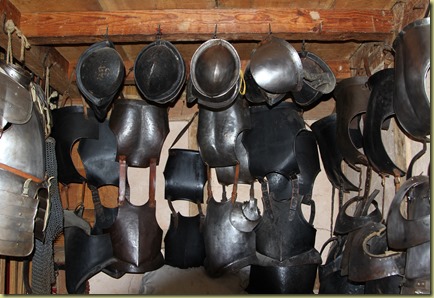
Ah, the armory. You all knew I’d find the armory. Sharp & shiny wins every time. Keeping all that cold iron from rusting in Virginia’s humidity must have been a serious chore.
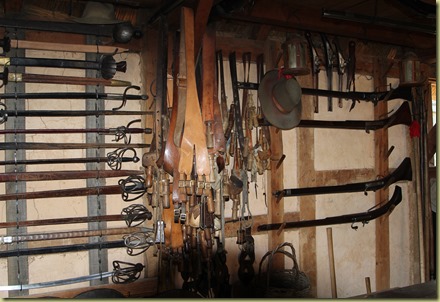
Lets see here, a modest selection of firelocks and a whole bunch of swords. The local inhabitants have bows & arrows, knives and war clubs. My money is on the locals, particularly in the rain.
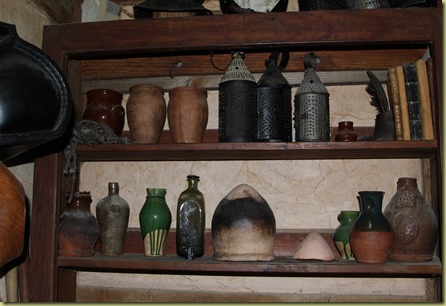
The armory also had the supplies for the Watch. The lanterns aren’t meant to light your way but to carry a lighted candle from one location to another without it blowing out.
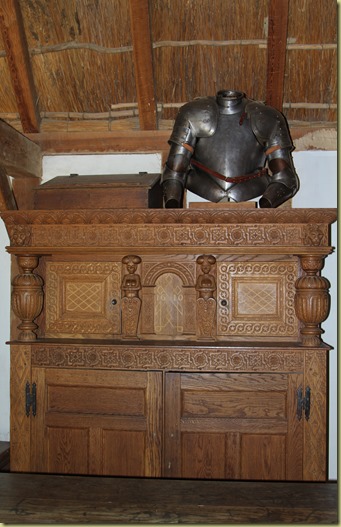
This is the governor’s house. Of course he has his own house as befits his position and the house is furnished with the best of everything. He even gets a full set of upper body armor, rather than just a breastplate.
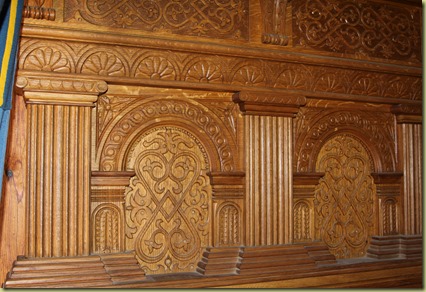
OK, I admit it – I’m a sucker for nicely carved wood.
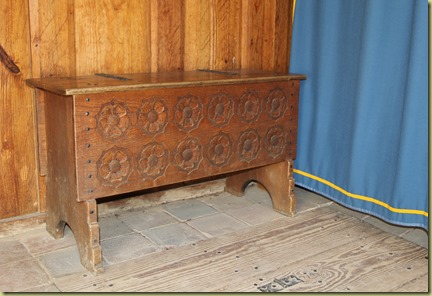
Curtains on the bed, tile floors, tightly paneled walls and a fine chest for your clothes. The wooden area of the floor is a door to a storage area for valuables.

Upholstered chairs and a warming hearth throughout the house. Such are the pleasures of being the governor. The hearth back is particularly nice.
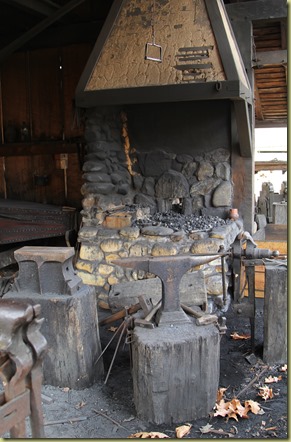
Of course a blacksmith was among the Jamestown settlers. Even the smallest English village would have had its blacksmith to make and repair farm tools & kitchen equipment. The smithy just wasn’t fired up today.
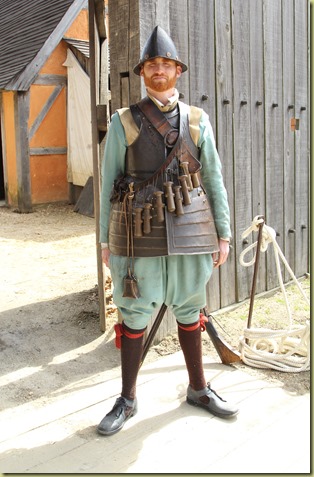
This fine fellow was guarding the Jamestown Settlement stockade entrance. He was the only interpreter not consistently mobbed by school kids while I was there. I plan on going back once school is out on a weekday to focus on the interpreters.
I spent Wednesday outside at Jamestown but Thursday was colder, overcast and given to spitting rain so I spent the day inside in the museum areas. No photography is allowed inside the museum. I also went to the NPS Jamestown site on Thursday and toured their museum areas. On the way back to the OVPR it was snowing so hard on the ferry crossing the James River I couldn’t see both banks of the river at once. Um, this is March amd I am in Virginia, right?
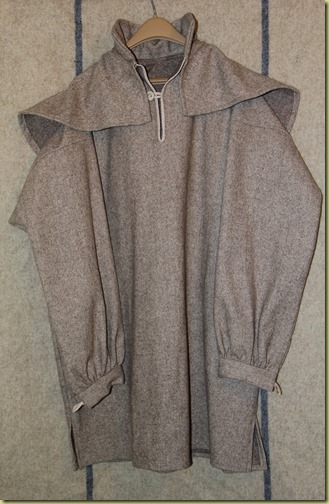
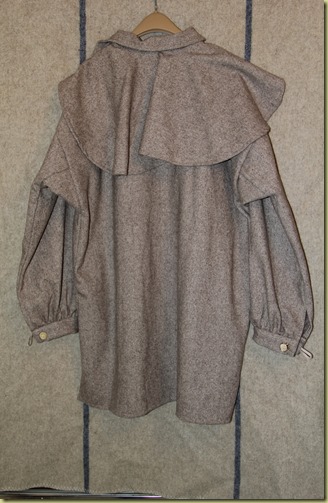
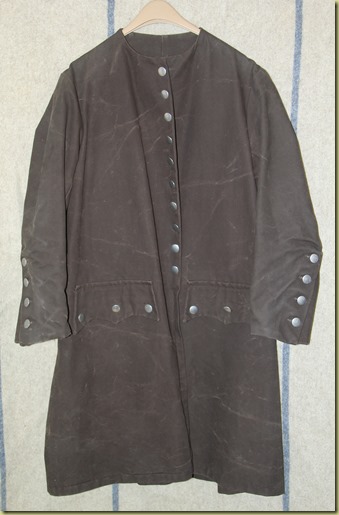
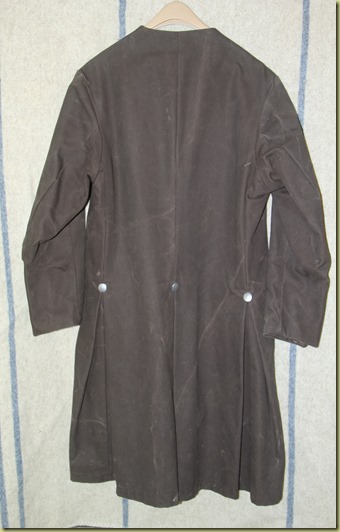
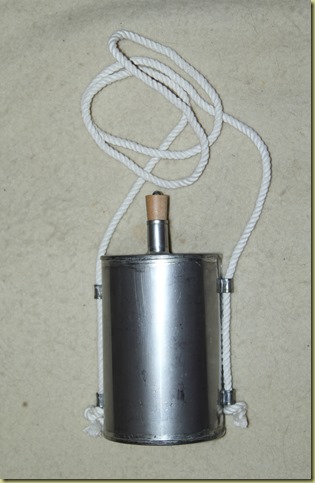
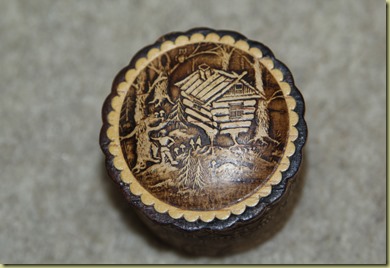
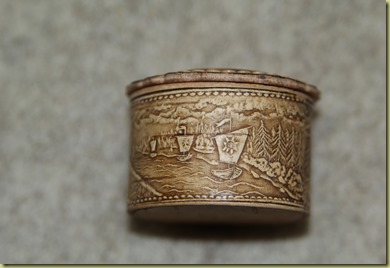
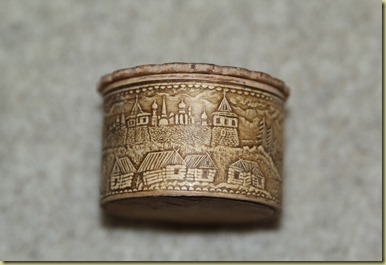
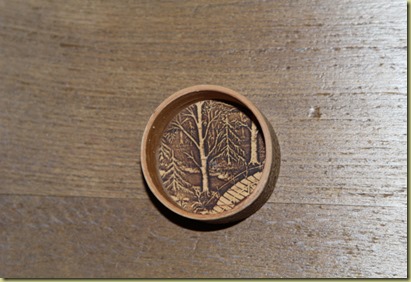
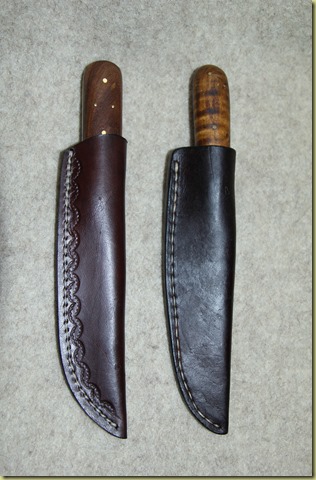
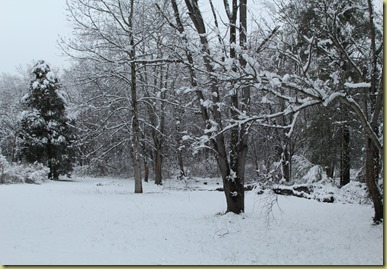
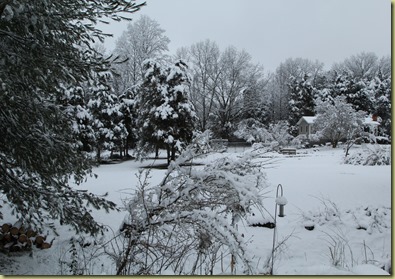
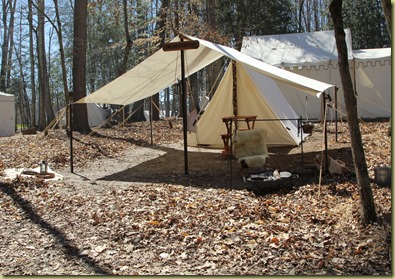
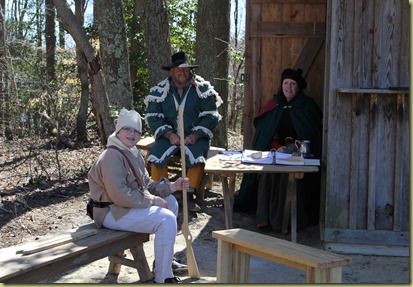
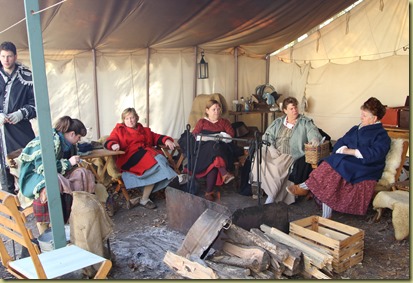
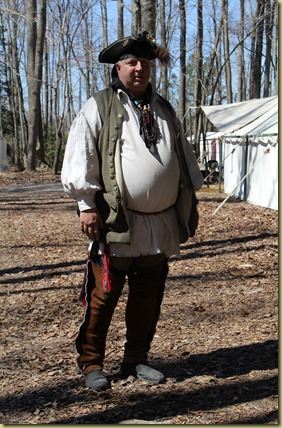

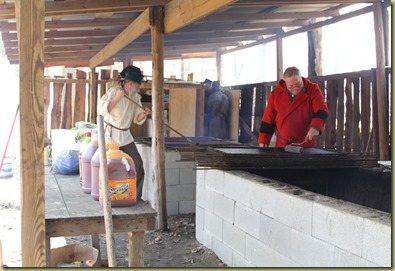
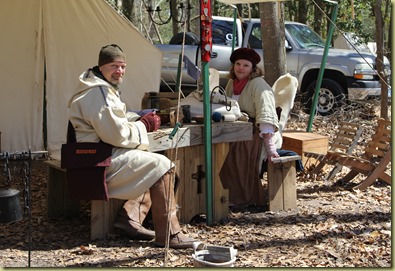

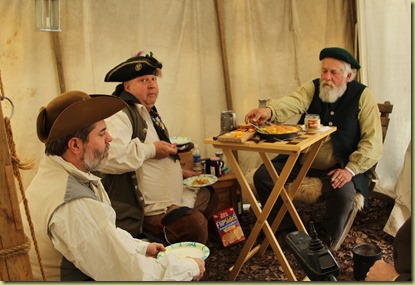
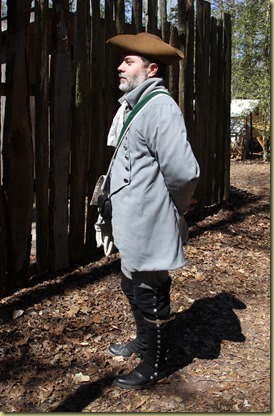

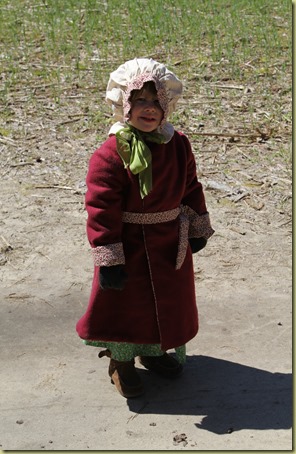
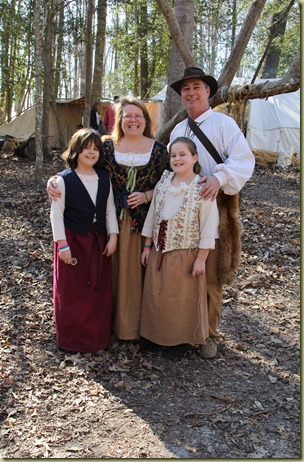
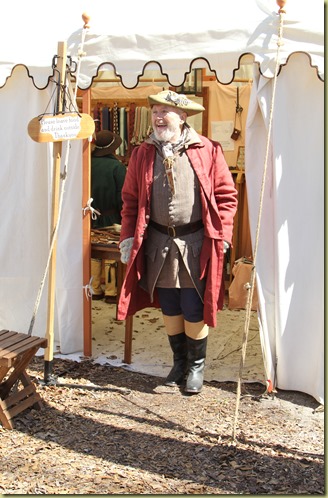
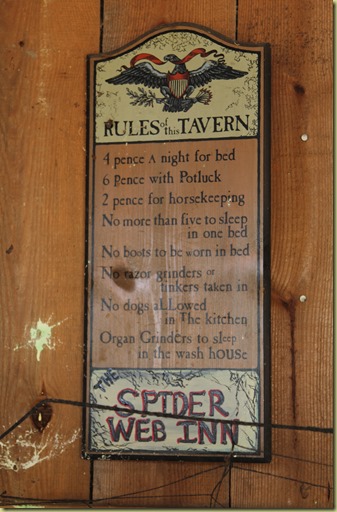
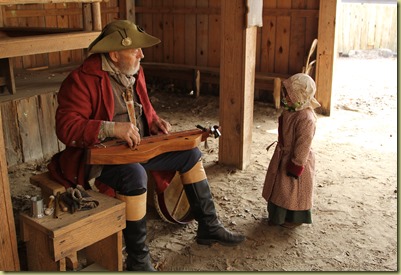
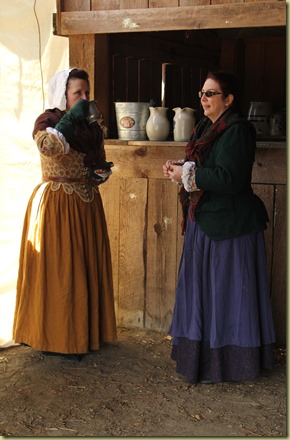
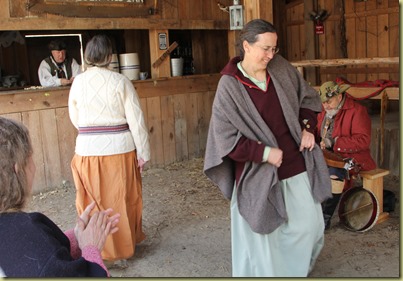
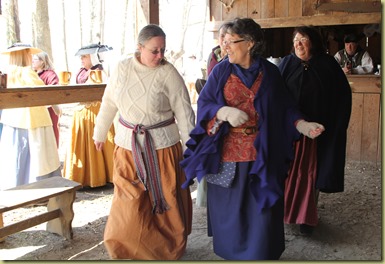
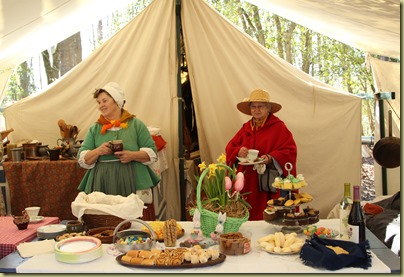
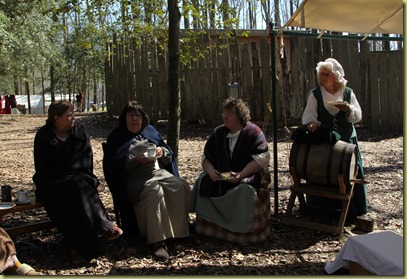
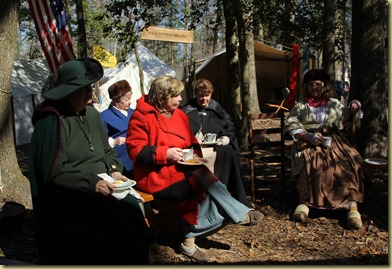
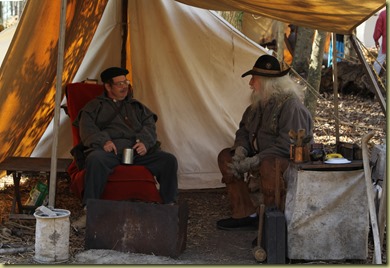

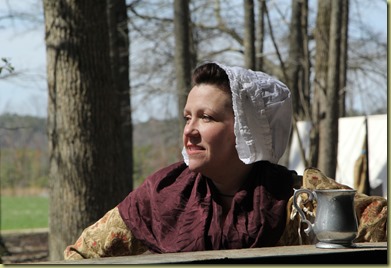
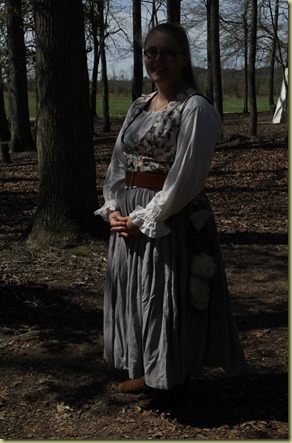










![IMG_0134[4] IMG_0134[4]](http://lh4.ggpht.com/-cQy0ntozSF4/UVXUbM8W6jI/AAAAAAAADHo/UDEntzhpyH4/IMG_0134%25255B4%25255D_thumb%25255B2%25255D.jpg?imgmax=800)































